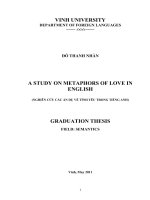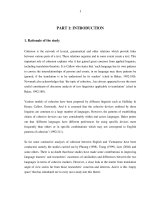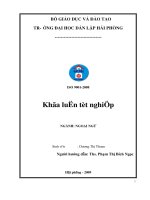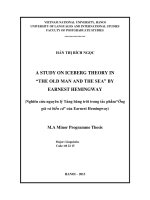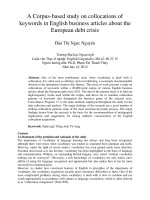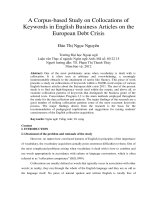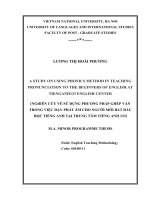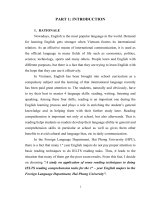A study on expressions of futurity in English in comparison with their Vietnamese equivalents
Bạn đang xem bản rút gọn của tài liệu. Xem và tải ngay bản đầy đủ của tài liệu tại đây (579.84 KB, 74 trang )
HAI PHONG PRIVATE UNIVERSITY
FOREIGN LANGUAGE DEPARTMENT
--------------***--------------
ISO 9001:2008
GRADUATION PAPER
A study ON expressions of futurity in English
in comparison with their Vietnamese
equivalents
By:
Nguyễn Thị Hồng Nhung
Class:
NA904
Supervisor:
Mai Thuý Phương, M.A
HAI PHONG, JUNE - 2009
1
Bộ giáo dục và đào tạo
Tr-ờng đại học dân lập hải phòng
----------------ooo----------------
Nhiệm vụ đề tài tốt nghiệp
Sinh viên: .....................................................................Mã số:................................
Lớp: .......................................Ngành:......................................................................
Tên đề tài:................................................................................................................
...
...
Nhiệm vụ đề tài
2
1. Nội dung và các yêu cầu cần giải quyết trong nhiệm vụ đề tài tốt nghiệp
(Về lý luận, thực tiễn, các số liệu cần tính toán và các bản vẽ)
................................................................................................................................................
................................................................................................................................................
................................................................................................................................................
................................................................................................................................................
................................................................................................................................................
2. Các số liệu cần thiết để thiết kế, tính toán
................................................................................................................................................
................................................................................................................................................
................................................................................................................................................
................................................................................................................................................
................................................................................................................................................
................................................................................................................................................
................................................................................................................................................
................................................................................................................................................
3. Địa điểm thực tập tốt nghiệp
................................................................................................................................................
................................................................................................................................................
................................................................................................................................................
................................................................................................................................................
................................................................................................................................................
Cán bộ h-ớng dẫn đề tài tốt nghiệp
Ng-ời h-ớng dẫn thứ nhất:
Họ và tên: ......................................................................................................................................
Học hàm, học vị: ...........................................................................................................................
3
Cơ quan công tác: .........................................................................................................................
Nội dung h-ớng dẫn: ....................................................................................................................
Ng-ời h-ớng dẫn thứ hai:
Họ và tên: ......................................................................................................................................
Học hàm, học vị: ...........................................................................................................................
Cơ quan công tác: .........................................................................................................................
Nội dung h-ớng dẫn: ....................................................................................................................
Đề tài tốt nghiệp đ-ợc giao ngày .... tháng ..... năm 2009
Yêu cầu phải hoàn thành xong tr-ớc ngày .... tháng .... năm 2009
Đã nhận nhiệm vụ Đ.T.T.N
Đã giao nhiệm vụ Đ.T.T.N
Sinh viên
Cán bộ h-ớng dẫn đề tài tốt nghiệp
Hải Phòng, ngày .... tháng .... năm 2009
Hiệu tr-ởng
GS.TS.NGƯT. Trần Hữu Nghị
Phiếu nhận xét tóm tắt của cán bộ h-ớng dẫn
1. Tinh thần thái độ của sinh viên trong quá trình làm đề tài tốt nghiệp:
.............................................................................................................................................
.............................................................................................................................................
4
.............................................................................................................................................
.............................................................................................................................................
.............................................................................................................................................
.............................................................................................................................................
2. Đánh giá chất l-ợng của Đ.T.T.N (So với nội dung yêu cầu đã đề ra trong nhiệm vụ Đ.T.T.N
trên các mặt lí luận, thực tiễn, tính toán giá trị sử dụng, chất l-ợng các bản vẽ)
.............................................................................................................................................
.............................................................................................................................................
.............................................................................................................................................
.............................................................................................................................................
.............................................................................................................................................
.............................................................................................................................................
3. Cho điểm của cán bộ h-ớng dẫn:
(Điểm ghi bằng số và chữ)
.............................................................................................................................................
.............................................................................................................................................
.............................................................................................................................................
Hải Phòng, ngày ... tháng ... năm 2009
Cán bộ h-ớng dẫn chính
(Họ tên và chữ ký)
Nhận xét đánh giá
của cán bộ chấm phản biện đề tài tốt nghiệp
1. Đánh giá chất l-ợng đề tài tốt nghiệp về các mặt thu nhập và phân tích số liệu ban đầu, cơ sở lý
luận chọn ph-ơng án tối -u, cách tính toán chất l-ợng thuyết minh và bản vẽ, giá trị lý luận và
thực tiễn của đề tài.
.............................................................................................................................................
5
.............................................................................................................................................
.............................................................................................................................................
.............................................................................................................................................
.............................................................................................................................................
.............................................................................................................................................
.............................................................................................................................................
.............................................................................................................................................
.............................................................................................................................................
2. Cho ®iÓm cña c¸n bé ph¶n biÖn
(§iÓm ghi b»ng sè vµ ch÷)
.............................................................................................................................................
.............................................................................................................................................
.............................................................................................................................................
.............................................................................................................................................
Ngµy .... th¸ng ... n¨m 2009
Ng-êi chÊm ph¶n biÖn
Table of contents
Acknowledgements
Part one: Introduction………………………………………………………………………………………………………
1
I. Rationale……………………………………………………………………………………………………………………………
1
II. Aims of the study ....................................................................................................................................................................
2
6
III. Scope of the study .................................................................................................................................................................
2
IV. Method of the study .........................................................................................................................................................
3
V. Design of the study................................................................................................................................................................
3
Part two: Development ..........................................................................................................................................................
4
Chapter one: Theoretical background...............................................................................................................
4
I. Verb .......................................................................................................................................................................................................
4
1. Definition .........................................................................................................................................................................................
4
2. Types of verb ...............................................................................................................................................................................
4
3. Verbal forms.................................................................................................................................................................................
4
II. Lexical verb ...................................................................................................................................................................................
6
1. The morphology of lexical verbs ............................................................................................................................
6
Regular lexical verbs ...........................................................................................................................................................
6
Irregular lexical verbs
7
.....................................................................................................................................................
2. Classification of lexical verbs ....................................................................................................................................
9
III. Tense and Aspect ................................................................................................................................................................
10
1. Tense.....................................................................................................................................................................................................
10
Present .................................................................................................................................................................................................
10
Past..........................................................................................................................................................................................................11 11
Future ...................................................................................................................................................................................................12 12
2. Aspect ..................................................................................................................................................................................................13 13
Simple aspect ...............................................................................................................................................................................13 13
Perfect aspect ...............................................................................................................................................................................13 13
Progressive aspect...................................................................................................................................................................14 14
7
Perfect progressive .................................................................................................................................................................14 14
Chapter two: Expressions of Futurity in English in Comparison with their
Vietnamese Equivalents .......................................................................................................................................................16 16
I. Expressions of futurity in English ...........................................................................................................................16 16
II. Differences between the expressions of futurity in English in comparison
with their Vietnamese equivalents.................................................................................................................................17 16
1. Be going to + infinitive .....................................................................................................................................................17 16
1.1. Structure .........................................................................................................................................................................................17 17
1.2. Usage.................................................................................................................................................................................................17 17
2. Simple future ................................................................................................................................................................................19 19
Structure ............................................................................................................................................................................................19 19
2.2.Usage ..................................................................................................................................................................................................21 21
3. Future continuous ...................................................................................................................................................................25 25
3.1. Structure .........................................................................................................................................................................................25 25
3.2. Usage.................................................................................................................................................................................................26 26
4. Future perfect ..............................................................................................................................................................................30 29
Structure ............................................................................................................................................................................................30
Ơ
29
Usage ....................................................................................................................................................................................................32
31
5. Future perfect continuous...............................................................................................................................................34
34
Structure ............................................................................................................................................................................................34
34
Usage ....................................................................................................................................................................................................36
35
6. Simple present for future .................................................................................................................................................38
37
Structure ............................................................................................................................................................................................38
37
8
Usage ....................................................................................................................................................................................................39 38
7. Present continuous for future .....................................................................................................................................41 40
Structure ............................................................................................................................................................................................41 40
Usage ....................................................................................................................................................................................................41 41
8. Be to + infinitive.......................................................................................................................................................................43 42
Arrangement or Command ...........................................................................................................................................43 42
Contingent future.....................................................................................................................................................................43 42
Be to + perfect infinitive ..................................................................................................................................................43 43
9. Be due to + infinitive ...........................................................................................................................................................44 43
Be due to ...........................................................................................................................................................................................44 43
Other structure............................................................................................................................................................................45 44
10. Future time in the past......................................................................................................................................................45 45
Would ..................................................................................................................................................................................................46 45
Be going to + infinitive .....................................................................................................................................................46 46
Past continuous ..........................................................................................................................................................................47 46
Be to + infinitive.......................................................................................................................................................................47 46
Be about to + infinitive......................................................................................................................................................48 47
Chapter three: Some Problems Possibly Faced by Vietnamese Learners,
Suggestions and Solutions ..................................................................................................................................................49 48
I. Possible problems faced by Vietnamese learners....................................................................................49 48
1. Misusing between Will and Going to ................................................................................................................49 48
In terms of showing Intention ....................................................................................................................................49 48
In terms of showing Prediction ................................................................................................................................50 49
9
In terms of showing Conditions ...............................................................................................................................51 50
2. Misusing between Simple Future and Future Continuous...........................................................53 52
A Specific time...........................................................................................................................................................................53 52
Question about somebody’s intention...............................................................................................................54 53
Non-continuous verbs/Mixed verbs ....................................................................................................................54 53
3. Misusage between Future Continuous and Future Perfect Continuous ........................55 54
II. Some solutions to overcome the problems ....................................................................................................56 55
1. Solutions to problems of misusage between Will and Going to ...........................................56 55
2. Solutions to problems of misusage between Simple Future and Future
Continuous...............................................................................................................................................................................................58 57
3. Solutions to problems of misusage between Future Continuous and Future
Perfect Continuous..........................................................................................................................................................................60 59
Part three: Conclusion ...........................................................................................................................................................62 61
References ..............................................................................................................................................................................................63 62
Appendix .................................................................................................................................................................................................64 63
10
Part one: Introduction
I. Rationale
Language is a typical individual feature of each country. It is a mean of
communicating and exchanging information, culture, technology, science, etc.
However, to communicate and exchange them among country all over the world, it
is necessary for people to use a common language. As you know, English is
described as global language. It has become increasingly important. In the global
integration process, English plays a main role. Thank to English, people can
connect each other, then enhance the understanding among the countries in all
aspect of life, and together create a developing world. As a result, English step by
step becomes the universal language.
It is the fact that using English effectively can help everyone to find a good job;
therefore, improving the English skills and levels is very necessary for people. That
is the reason why English is becoming compulsory subject at all schools. The
English curriculum improves learners’ ability to communicate and also fosters a
strong liberal arts background, marketable communication skills etc.
In the aspects of language, Grammar which plays an important role in governing the
use of a given natural language is a field of linguistics. Traditionally, grammar
included morphology and syntax; in modern linguistics these subfields are
complemented by phonetics, phonology, semantics, and pragmatics. English
grammar is a body of rules specifying how meanings are created in English.
English grammar is investigated and studied by many grammarians with many
aspects, in which the futurity expressions in English are a popular phenomenon.
The futurity in English can be express in several different ways depending on
context of the surrounding information, semantic, timing, speaker attitude or
opinion, etc. These are quite complex to determine. As the literature concerning the
11
future in English is wide, it may take many years of study for a learner to
accomplish native speaker-like use of these constructions.
Furthermore, each language has individual references to the future time. Thus when
studying these expressions of futurity in English, many foreign learners, especially
Vietnamese learners have difficulties in mastering. Those are the reasons why I
want to focus on Expressions of futurity in English in comparison with their
Vietnamese equivalents. I hope that the study will help Vietnamese learners to
understand more clearly and use more effectively these expressions.
II. Aims of the study
The study is aimed at:
Supplying an overall investigation into expressions of futurity in English with
focus on form and usage.
Figuring out the similarities and differences between these expressions.
Identifying some possible problems faced by learners in using these
expressions and some solutions.
III. Scope of the study
I can study about future expressions but in this paper, I only focus on expressions of
futurity in English with restrictions on their forms and usage as well as Vietnamese
equivalents. Because each langue has its individual grammar, Vietnamese grammar
is different from English one. In grammar Vietnamese, the parts such as: ‚tense‛ or
‘aspect‛ are rather unfamiliar; therefore, it is very difficult for Vietnamese learners
not to make mistakes when studying future tense, especially expressions of futurity
in English. Thus, in this study, what are expressions of futurity in English, their
forms & usage as well as Vietnamese equivalents which are made out.
12
Effort was made to do this paper as I expect that this study to some extent will
provide for those who pay attention to some problems faced by Vietnamese learners
when learning Expressions of English futurity.
IV. Methods of the study
To carry out the study, data are first collected from reliable books and websites then
they are analysed to find out the common use of futurity expressions as well as their
distinctive meanings.
Next to, a comparative study is made between expressions of futurity in English
their Vietnamese equivalents (only at level of translating English sentences
containing expressions of futurity in English into Vietnamese).
The results attained from the comparative study are then analysed in order to find
out the basis on which futurity expressions are used and reflect their meanings.
Also, some problems are hypothesized and then addressed with certain effective
measures to tackle.
V. Design of the study
The study consists of three main parts, namely:
The introduction in which rationale, aims of the study, scope, methods and
design are presented
The Development includes:
Chapter one presenting an overview of verbs and related issues
Chapter two elaborating Expressions of futurity in English in comparison with
their Vietnamese equivalents
Chapter three dealing with problems possibly encountered by Vietnamese
learners, suggestions and solutions to these problems
The conclusion, in which related issues in the study are summed up and some
suggestions for further study are presented.
13
Part two: development
Chapter one: Theoretical background
I. Verb
1. Definition
Verb is the part of speech (or word class) that describes an action or occurrence or
indicates a state of being.
(www.grammar.about.com)
2. Types of verb
There are various ways in which will be necessary to classify verbs. According to
Quirk (1994: 25) basing on the functions of verb phrases, they are classified into
- Lexical
walk, write, play, etc
- Auxiliary 1/ Primary
be, do, have
2/ Modal
can, may, could, etc
3. Verbal forms
According to Quirk (1994: 25), many English verbs have five forms: the BASE, the
–s FORM, the PAST, the –ING PARTICIPLE, and the –ED PARTICIPLE.
Example of these forms and an indication of their functions are given in the table
below. Regular lexical verbs have the same -ed inflection for both the past tense
and the -ed participle (called). Irregular lexical verb forms vary from three (e.g.:
put, puts, putting) to eight (be, am, are, was, were, being, been). The modal
auxiliaries are defective in not having infinitive (* to may), -ing participle (*
maying), -ed participle (* mayed), or imperative (* may!)
14
Form
Symbol E.g.
Function
(1) base
V
(a) all the present tense except 3rd person
singular: I/you/we/they call every day
Call
Drink
Put
(b) subjunctive: He demanded that she
call and see him
(c) the bare infinitive: He may call; and
the to infinitive: He wants her to call
(2) –s form(3rd V-s
person
singular
present)
Calls
(3) past
Called
V-ed1
Drinks
3rd person singular present tense:
He/she/it calls every day
Puts
Past tense: He called yesterday
Drank
Put
(4) –ing
participle
(present
participle)
V-ing
(5) –ed
V-ed2
participle (past
participle)
Calling
(a) progressive aspect (be + V-ing): He’s
Drinking calling in a moment
(b) in –ing participle clauses: Calling
Putting
early, I found her at home
Called
Drunk
Put
(a) perfective aspect (have + V-ed2): He
has drunk the water
(b) passive voice (be + V-ed2): He is
called Jack
(c) in –ed participle clauses: Called early,
he had a quick breakfast
The abbreviation V-ed will be used to where V-ed1 has the same form as V-ed2.
15
II. Lexical verbs
1. The morphology of lexical verbs
According to Quirk, R. et. al. (1994: 27), we will consider lexical verbs under two
heads: regular (such as call) and irregular (such as drink). In all of them, the –s
form and –ing participle are predictable from the base form. They different in that
the –ed1, and –ed2 forms in irregular verbs cannot be predicted from the base.
Regular lexical verbs
Regular lexical verbs have the following forms:
V
Base
Call
Like
Try
V-ing
-ing participle
Calling
Liking
Trying
V-s -es
Form
Calls
Likes
Tries
V-ed
Past/ -ed Participle
Called
Liked
Tried
The -ing and -s forms
The -ing form is straightforward addition to the base
Push – pushing
sleep – sleeping
The –s form is also predictable from the base. It has three spoken realizations: /iz/,
/z/, and /s/, and two spellings, -s and -es.
(1) Pronounced /iz/ after bases ending in voiced or voiceless sibilant and spelled
-es unless the base already ends in –e:
Pass – passes
budge - budges
Buzz – buzzes
push – pushes
(2) Pronounced /z/ and spelled -s after bases ending in other voiced sounds:
Call – calls
rob – robs
16
flow – flows
(3) Pronounced /s/ and spelled -s after bases ending in other voiceless sounds:
Cut – cuts
lock – locks
sap – saps
The past and the -ed participle
The past (V-ed1) and the -ed participle (V-ed2) regular verbs (spelling -ed unless
the base ends in -e) have three spoken realizations:
/id/ after bases ending in /d/ and /t/:
Pad – padded
pat – patted
/d/ after bases ending in voiced sounds other then /d/:
/t/ after bases ending in voiceless sounds other than /t/:
Pass – passed
pack – packed
Irregular lexical verbs
Irregular verbs have a varying number of distinct forms. Since the -s and -ing forms
are predictable for regular and irregular verbs alike, the only forms that need be
listed for irregular verbs are the base (V), the past (V-ed1), and the past participle
(V-ed2). Most irregular verbs have, like regular verbs, only one common variation
in this respect, as the table shows:
BASE
V-ed1
V-ed2
All like
Cut
Cut
Cut
V-ed1 = V-ed2
Meet
Met
Met
V= V-ed2
Come
Came
Come
All different
Speak
Spoke
Spoken
Classification
Class 1: V-ed1 is identical with V-ed2
17
Suffixation is used but voicing is variable
Vowel identify in all the parts
V
V-ed
V
V-ed
Burn
Burnt
Bend
Bent
smell
smelt
make
made
Class 2: V-ed1 is identical with V-ed2
Suffixation is used but voicing is variable
Change of base vowel
V
V-ed
V
V-ed
Creep
Crept
Catch
Caught
dream
dreamt
say
said
Class 3: All three parts V, Ved1, and V-ed2 are identical
No suffix of change of the base vowel
V and V-ed
V and V-ed
V and V-ed
Bet (r)
Knit (r)
Shut
Class 4: V-ed1 is identical with V-ed2
No suffixation
Change of base vowel
V
V-ed
V
V-ed
Meet
Met
Sit
Sat
Dig
Dug
fight
Fought
18
Class 5: V-ed1 is regular; V-ed2 has two forms, one regular, the other nasal.
V
V-ed1
V-ed2
V
V-ed1
V-ed2
Hew
Hewed
Hewn (R)
Shear
Sheared
Shorn (R)
Mow
Mowed
Mown (R)
Swell
Swelled
Swollen (R)
Class 6: V-ed1 and V-ed2 are irregular, the latter always suffixed and usually
with -(e)n. There are subclasses as follows:
A: V-ed1 and V-ed2 have the same vowel
B: V and V-ed2 have the same vowel
C: all three parts have different vowels
D: all three parts have the same vowel
E: V-ed1 and V-ed2 have different vowels.
V
V-ed1
V-ed2
V
V-ed1
V-ed2
A
Break
Broke
Broken
C
Drive
Drove
Driven
A
Wear
Wore
Worn
D
Beat
Beat
Beaten
B
Shake
Shook
Shaken
E
Dive
Dove
Driven
Class 7: V-ed1 and V-ed 2 are irregular; there is no suffixation but there is
always some vowel change.
V
V-ed1
V-ed2
Begin
Began
Begun
Come
Came
Come
2. Classification of lexical verbs
There are four ways to classify lexical verbs. According to:
19
Progressive aspectual contrast
2 types:
Dynamic verbs
Stative verbs
The relationship between Verbs and other sentence elements:
2 types:
Intensive verbs. For example: She is beautiful
Extensive verbs. For Example: She dislikes apples
Word-formation (morphologically):
3 types:
Simple verbs: run, go, drive, etc
Derive verbs: a root and more than an affix enlarge.
Compound verbs: undergo, undertake, etc
Verb complementation:
5 types:
Intensive: SVC, SVA
Intransitive: SV
Monotransitive: SVO
Ditransitive: SVOO
Complextransitive: SVOC, SVOA
III. Tense and Aspect
1. Tense
Time is a universal, non-linguistic concept with three divisions: past, present and
future; by tense we understand the correspondence between the form of the verb
and our concept of time.
In English, there are three basic tenses: past, present and future.
1.1. Present
20
We need distinguish three basic types of present:
Timeless, expressed with the simple present form:
- I (always) write with a special pen (when I sign my name)
(Quirk 1994: 40)
As well as expressing habitual action as here, the timeless present is used for
universal statements such as:
- The sun sets in the west
(Quirk 1994: 40)
- Spiders have eight legs
(Quirk 1994: 40)
Limited, expressed with the present progressive:
- I am writing (on this occasion) with a new pen (since I have mislaid my
ordinary one)
(Quirk 1994: 40)
Instantaneous, expressed with either the simple (especially in a series) or the
progressive form:
- As you see, I am dropping the stone into the water.
(Quirk 1994: 41)
1.2. Past
An action in the past may be seen:
As having taken place at a particular point of time:
- I wrote my letter of 16 June 1972 with a special pen
(Quirk 1994: 41)
As over period extending up to the present:
21
- I have written with a special pen since 1972
(Quirk 1994: 41)
As over period relating to only past having been completed:
- I wrote with a special pen from 1969 to 1972
(Quirk 1994: 41)
As over period to past, not having been completed:
- I was writing poetry with a special pen
(Quirk 1994: 41)
1.3. Future
According to Quirk (1994: 46) there is no obvious future tense in English, future
time is rendered by means of modal auxiliaries, semi-auxiliaries, simple present
forms or progressive forms. For examples:
- They will have finished their book by next year (Modal auxiliary: will)
(Quirk 1994: 47)
- When are you going to get married? (Be going to + infinitive)
(Quirk 1994: 47)
- He is moving to London (Present progressive)
(Quirk 1994: 47)
- What time is the football match? (Simple present)
(Quirk 1994: 48)
- We are to be married soon (Be to + infinitive)
(Quirk 1994: 49)
- The time was not far off when he would regret this decision. (Future time in the past)
(Quirk 1994: 49)
22
2. Aspect
Aspect refers to the nature of the action described by the verb. There are four
aspects: indefinite (or simple), complete (or perfect), continuing (or progressive)
and perfect continuous.
2.1. Simple aspect
The simple aspect, which is the base form of the verb- is often used, on the other
hand, to describe permanent actions or events:
- The children are very naughty.
(BBC World Service Learning English Ask about English.com)
This example we use the simple aspect of the present tense of the verb ‚to be‛, in
which the children’s naughtiness is not seen as a temporary event, but as a
permanent state. They are not going though a naughty stage – they are always
naughty!
Again, you have shown your perspective on the duration of the event, the
naughtiness, by choosing the simple aspect, ‚are naughty‛.
2.2. Perfect aspect
Have + V-ed
The perfect aspect is expressed with the auxiliary have and the third form of the
verb, which is also called the past participle. Depending on the time of the action,
we use the past, present or modal + infinitive form of have.
The perfect aspect expresses that the action had, has or will have been completed by
a particular point of time. This point of time can be defined by a time expression or
a clause (by 5 o'clock, by the time she gets home).
- I've never been to China.
- By 5 o'clock he had finished the letter.
23
- Kevin will have done the ironing by the time Susan gets home.
(English grammar.com)
2.3. Continuous aspect
Be + V-ing
The continuous aspect is expressed with the auxiliary be and the -ing form of the
verb, which is also called the present participle. Depending on the time of the
action, we use the past, present or modal + infinitive form of be.
The continuous aspect expresses that the action was, is or will be in progress at a
particular point of time or over a period of time. A point of time can be defined by a
time expression (now, at 5 o'clock) or a clause (when I came home,). For a period of
time we can also use a time expression (all day yesterday) or a clause (while she
was reading).
- Are you enjoying yourself?
- At 5 o'clock I was sitting on the bus.
- When I came home, she was sleeping.
- While she was reading, George was doing the dishes.
(English grammar.com)
2.4. Perfect continuous aspect
Have been + V-ing
This is not an aspect in itself but the combination of the perfect and continuous
aspects. Depending on the time of the action, we use the past, present, modal +
infinitive form of have. The perfect continuous means that the action had, has or
will have been in progress for some time at a particular point of time. This point of
time can be defined by a time expression or a clause (at 5 o’clock, when she gets
home).
24
- I have been waiting for this moment all my life.
- At 5 o’clock he had been writing his homework for an hour.
- When she gets home, Kevin will have been sleeping for hours.
(English grammar.com)
25
